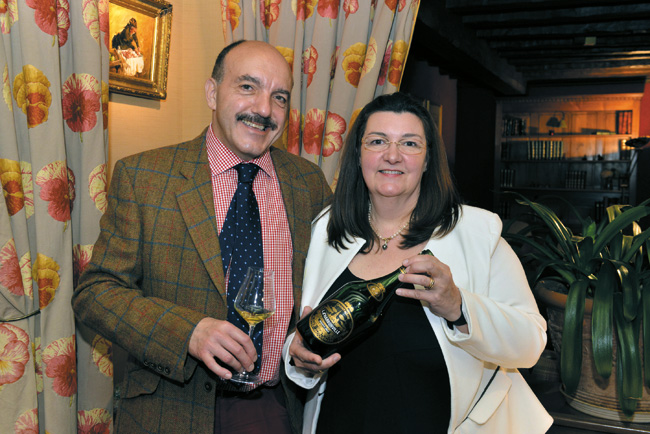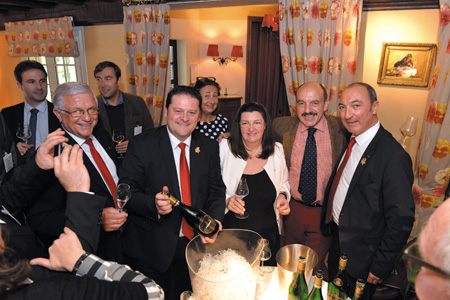Founded in 1930 by Marcel Ployez and Yvonne Jacquemart, the family house Ployez-Jacquemart celebrates its 85th anniversary in 2015! Laurence Ployez, heiress of the 3rd generation, marked the event by organizing, at La Briqueterie on October 5th 2015, a vertical tasting of her cuvée Liesse d’Harbonville, vintages 1966 to 1988, in the presence of Gérard Basset, Best Sommelier of the World 2010, Michel Hermet, president of the French Sommellerie, and some eminent sommeliers of Champagne.
 Gérard Basset and Laurence Ployez
Gérard Basset and Laurence PloyezCurrent manager of the eponymous house, Laurence Ployez organized this vertical tasting in tribute to her grandmother Yvonne Jacquemart, founder of the house, and to highlight her 50-year-old prestige cuvée Liesse d’Harbonville whose name comes from Yvonne's great-aunt, a pretty and precious lady!
Yvonne created this premium cuvée in 1966. In the wine library only two bottles of this historical vintage, disgorged in 1975, were left. Laurence treated us with one bottle for tasting at La Briqueterie, specifying its 100% Blanc de Blancs composition, stemming from hundred-year-old vines. What an emotion when the cork freed this Champagne. Gérard Basset appreciated “this beautiful experience”. And commented “the old gold colour with bronze tinges, livened up with some bubbles, medium tears that run regularly. In the nose, no oxidization, but rather touches of rancio, caramel, beeswax, scents of dried flowers, compote, marmalade. The round palate was smooth, creamy, with flavours of candied apricot, and still presented a certain minerality and freshness. The grande dame of another time that exuded elegance, harmony and pride, deserved to be paired with exceptional dishes cooked by themselves, like white Alba truffle braised under ash or semi-cooked Périgord foie gras”.

Laurence Ployez surrounded by Gerard Basset,
Michel Hermet and the sommeliers of Champagne.
“All of the next vintages, Laurence confided, have been crafted by daddy. He only declared vintage, in the extraordinary years, the most astonishing grape varieties, in a small vat, for pleasure!” Then came the 1978 vintage, a Blanc de Noirs, crafted with 100% Pinot Noir from Mailly Champagne (from the house's own vineyard). Its magnificent nose, just like perfume, inspired the sommeliers to intone Cat Steven's My lady d’'Harbonville', why do you sleep so still. Its warm pastry flavours, then Asian spices and jasmine, filled the tasters with enthusiasm and confirmed they were attending a very special degustation. Its very supple palate, very silky, with a real saltiness in the aftertaste, invited to enjoy this illustrious bottling with a lobster Thermidor. When asked by Yves Chapier why such a gap in time from 1966 and 1978, Laurence explained that she lost many venerable bottlings in her wine library because the wire-caps went rusty and the corks popped out. The family thus decided to stop the disgorged vintages with wax as soon as the sale is over.
Liesse d’Harbonville 1979 made the sommeliers enthusiast thanks to its youth. Made with Premier and Grand Cru white grapes from Mailly, Cuis, Mesnil-sur-Oger, Bisseuil and other growths from the Côte des Blancs area, its nose with scents of blonde tobacco supported by notes of fruits and iodized flavours surprised the audience. Eric Arnaud thinks “the vintage 1979 is more vivid, more phenolic than the 1978” and goes on: “1979 has been a great year for Chardonnay. This cuvée Liesse d’Harbonville 1979 has an unsuspected freshness for its age. It exudes an empire of essences even more unexpected that it has been disgorged a long time ago”! Laurence adds she “uses only wine and cane sugar at disgorgement. And the ageing head down avoids the contact of the wine with the yeasts, source of ageing”. Yves Chapier adds that “at that time acidity was important, the yields were small and the grapes more concentrated” which explains the exceptional conservation.
Closer to us, the vintage 1982, crafted with 50% Pinot Noir and as much Chardonnay, “presented a real sparkling in the mouth like a gastronomic Champagne, a wine for a meal, Michel Hermet declared. The last vintage nearly tastes like 1978 with notes of mild spices, slightly caramelized, aromas of warm pastry. But on the palate it asserts its powerfulness, finesse and freshness and an excellent balance. And, he concluded, to help this wine fully express, I advise to serve it with a fattened chicken en demi-deuil (truffled) with pan-fried autumn mushrooms”.
Then came Liesse d’Harbonville 1985, a mythical year in Champagne, that the great houses keep in their wine library like treasures. Gérard Basset believes “this vintage is in line with the current wines with its straw yellow colour livened up by a slender sparkling, its aromas of white flowers and lemon grass, its acidity on the palate and its very vivid aftertaste, it seems impossible to me to discover it is thirty years old in a blind tasting! Its lightness and asserted character enables to enjoy it for the aperitif or to serve it over an entire meal from the starter on a noble fish terrine, followed by a grilled turbot, pan-fried ceps or a fillet of veal with gravy”.
The year 1988 marks a great shift in the crafting of this cuvée of excellence. Laurence and her father decided on the blend of Liesse d’Harbonville that would from then be composed of 2/3 Chardonnay and 1/3 Pinot Noir and Meunier. And they stated it would be vinified in three to five times used oak barrels during seven months, that it would not undergo malolactic fermentation nor filtering nor stirring of the lees anymore, only rackings! When opened, what sensations! It surprises the professionals with its elegance, balance, fruity flavours, the texture of its sparkling, its finesse, its freshness. Eric Arnaud, president of the sommeliers of Champagne, concludes: “We can nearly turn it into a Champagne for the aperitif that would open up over a festive meal!”
And Gérard Basset described the degustation as “a beautiful achievement that confirms the cuvée Liesse d’Harbonville is a genuine Champagne wine, and each sip of each of these historical vintages is an invaluable testament”.